#d1cddb Color Information
In a RGB color space, hex #d1cddb is composed of 82% red, 80.4% green and 85.9% blue. Whereas in a CMYK color space, it is composed of 4.6% cyan, 6.4% magenta, 0% yellow and 14.1% black. It has a hue angle of 257.1 degrees, a saturation of 16.3% and a lightness of 83.1%. #d1cddb color hex could be obtained by blending #ffffff with #a39bb7. Closest websafe color is: #cccccc.
-
- R 82
- G 80
- B 86
-
- C 5
- M 6
- Y 0
- K 14
● #d1cddb color description : Light grayish violet.
#d1cddb Color Conversion
The hexadecimal color #d1cddb has RGB values of R:209, G:205, B:219 and CMYK values of C:0.05, M:0.06, Y:0, K:0.14. Its decimal value is 13749723.
| Hex triplet | d1cddb | #d1cddb |
|---|---|---|
| RGB Decimal | 209, 205, 219 | rgb(209,205,219) |
| RGB Percent | 82, 80.4, 85.9 | rgb(82%,80.4%,85.9%) |
| CMYK | 5, 6, 0, 14 | |
| HSL | 257.1°, 16.3, 83.1 | hsl(257.1,16.3%,83.1%) |
| HSV (or HSB) | 257.1°, 6.4, 85.9 | |
| Web Safe | cccccc | #cccccc |
| CIE-LAB | 83.09, 3.963, -6.439 |
|---|---|
| XYZ | 60.91, 62.332, 75.836 |
| xyY | 0.306, 0.313, 62.332 |
| CIE-LCH | 83.09, 7.561, 301.612 |
| CIE-LUV | 83.09, 1.413, -10.572 |
| Hunter-Lab | 78.951, -0.453, -1.686 |
| Binary | 11010001, 11001101, 11011011 |
Color Schemes with #d1cddb
Alternatives to #d1cddb
Below, you can see some colors close to #d1cddb. Having a set of related colors can be useful if you need an inspirational alternative to your original color choice.
#d1cddb Preview
This text has a font color of #d1cddb.
<span style="color:#d1cddb;">Text here</span>This paragraph has a background color of #d1cddb.
<p style="background-color:#d1cddb;">Content here</p>This element has a border color of #d1cddb.
<div style="border:1px solid #d1cddb;">Content here</div>.text {color:#d1cddb;}.background {background-color:#d1cddb;}.border {border:1px solid #d1cddb;}Shades and Tints of #d1cddb
A shade is achieved by adding black to any pure hue, while a tint is created by mixing white to any pure color. In this example, #060507 is the darkest color, while #fbfbfc is the lightest one.
-
#060507
#060507rgb(6,5,7) -
#0f0d12
#0f0d12rgb(15,13,18) -
#18151e
#18151ergb(24,21,30) -
#211e29
#211e29rgb(33,30,41) -
#2a2635
#2a2635rgb(42,38,53) -
#332e40
#332e40rgb(51,46,64) -
#3c364b
#3c364brgb(60,54,75) -
#453f57
#453f57rgb(69,63,87) -
#4f4762
#4f4762rgb(79,71,98) -
#584f6e
#584f6ergb(88,79,110) -
#615779
#615779rgb(97,87,121) -
#6a5f84
#6a5f84rgb(106,95,132) -
#736890
#736890rgb(115,104,144)
-
#7d7299
#7d7299rgb(125,114,153) -
#887da2
#887da2rgb(136,125,162) -
#9289aa
#9289aargb(146,137,170) -
#9d94b2
#9d94b2rgb(157,148,178) -
#a79fba
#a79fbargb(167,159,186) -
#b2abc2
#b2abc2rgb(178,171,194) -
#bcb6cb
#bcb6cbrgb(188,182,203) -
#c7c2d3
#c7c2d3rgb(199,194,211) -
#d1cddb
#d1cddbrgb(209,205,219) -
#dbd8e3
#dbd8e3rgb(219,216,227) -
#e6e4eb
#e6e4ebrgb(230,228,235) -
#f0eff4
#f0eff4rgb(240,239,244) -
#fbfbfc
#fbfbfcrgb(251,251,252)
Tones of #d1cddb
A tone is produced by adding gray to any pure hue. In this case, #d4d4d4 is the less saturated color, while #c3acfc is the most saturated one.
-
#d4d4d4
#d4d4d4rgb(212,212,212) -
#d2d0d8
#d2d0d8rgb(210,208,216) -
#d1cddb
#d1cddbrgb(209,205,219) -
#d0cade
#d0cadergb(208,202,222) -
#cec6e2
#cec6e2rgb(206,198,226) -
#cdc3e5
#cdc3e5rgb(205,195,229) -
#cbc0e8
#cbc0e8rgb(203,192,232) -
#cabcec
#cabcecrgb(202,188,236) -
#c8b9ef
#c8b9efrgb(200,185,239) -
#c7b6f2
#c7b6f2rgb(199,182,242) -
#c6b3f5
#c6b3f5rgb(198,179,245) -
#c4aff9
#c4aff9rgb(196,175,249) -
#c3acfc
#c3acfcrgb(195,172,252)
Color Blindness Simulator
Below, you can see how #d1cddb is perceived by people affected by a color vision deficiency. This can be useful if you need to ensure your color combinations are accessible to color-blind users.
